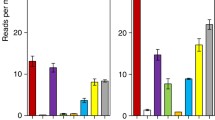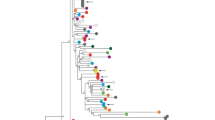Abstract
The insertion site number of the retrotransposable element 412 was analyzed in natural populations ofDrosophila simulans of worldwide origin by in situ hybridization. We observe a gradient in copy number ranging from as high as 23 in Europe to 1–10 in South Africa, while populations in Madagascar and the Indian Islands, which are the cradle ofD. simulans, have only 3–7 copies. We find very different copy numbers in some local populations of Australia and the Pacific Islands (with around 60 copies in 1 sample and only 5 in another), suggesting spontaneous transposition bursts in local populations. Such bursts occurring now and then in local natural populations followed by fly migration could lead to the progressive invasion of the entire species by the transposable element mobilized, explaining the gradient in 412 copy number between northern and southern hemispheres.
Similar content being viewed by others
References
Anxolabéhère D, Nouaud D, Periquet G, Tchen P (1985) P-element distribution in Eurasian populations ofDrosophila melanogaster: a genetic and molecular analysis. Proc Natl Acad Sci USA 82:5418–5422
Aulard S, Lemeunier F, Hoogland C, Chaminade N, Brookfield JF, Biémont C (1995) Chromosomal distribution and population dynamics of the 412 retrotransposon in a natural population ofDrosophila melanogaster. Chromosoma 103:693–699
Baba Aïssa F, Solignac M (1984) La plupart des populations deDrosophila simulans ont probablement pour ancêtre une femelle unique dans un passé récent. C R Acad Sci III 299:289–292
Baba Aïssa F, Solignac M, Dennebouy N, David J (1988) Mitochondrial DNA variability inDrosophila simulans: quasi absence of polymorphism within each of the three cytoplasmic races. Heredity 61:419–426
Begun DJ, Aquadro CF (1995) Molecular variation at the vermilion locus in geographically diverse populations ofDrosophila melanogaster andD. simulans. Genetics 140:1019–1032
Biémont C (1994) Dynamic equilibrium between insertion and excision of P element in highly inbred lines from an M′ strain ofDrosophila melanogaster. J Mol Evol 39:466–472
Biémont C (1995) Estimating heterozygosity inDrosophila from transposable element copy numbers. Trends Genet 11:299
Biémont C, Aouar A, Arnault C (1987) Genome reshuffling of the copia element in aDrosophila melanogaster inbred line. Nature 329:742–744
Biémont C, Arnault C, Heizmann A, Ronsseray S (1990) Massive changes in genomic locations of P elements in an inbred line ofDrosophila melanogaster. Naturwissenschaften 77:485–488
Biémont C, Gautier C (1989) Interactions between transposable elements for insertion in theDrosophila melanogaster genome. Heredity 63:125–133
Biémont C, Lemeunier F, Gautier C, Garcia Guerreiro MP, Aulard S, Pasyukova EG (1994) High rate of movement of one (Mdg3) out of four transposable elements in a natural population ofDrosophila melanogaster. C R Acad Sci III 317:283–286
Busseau I, Chaboissier MC, Pélisson A, Bucheton A (1994) I factors inDrosophila melanogaster: transposition under control. Genetica 93:101–116
Capy P, Anxolabéhère D, Langin T (1994) The strange phylogenies of transposable elements: are horizontal transfers the only explanation? Trends Genet 10:7–12
Capy P, Pla E, David JR (1993) Phenotypic and genetic variability of morphometrical traits in natural populations ofDrosophila melanogaster andD. simulans. I. Geographical variations. Géét Sél Evol 25:517–536
Charlesworth B, Charlesworth D (1983) The population dynamics of transposable elements. Genet Res 42:1–27
Charlesworth B, Langley CH (1991) Population genetics of transposable elements inDrosophila. In: Selander RK, Clark AG, Whittam TS (eds) Evolution at the molecular level. Sinauer, Sunderland, MA
Charlesworth B, Lapid A (1989) A study of 10 transposable elements on X chromosomes from a population ofDrosophila melanogaster. Genet Res 54:113–125
Charlesworth B, Lapid A, Canada D (1992) The distribution of transposable elements within and between chromosomes in a population ofDrosophila melanogaster. II. Inferences on the nature of selection against elements. Genet Res 60:115–130
Choudhary M, Singh RS (1987) A comprehensive study of variation in natural populations ofDrosophila melanogaster. III. Variations in genetic structure and their causes betweenDrosophila melanogaster and its sibling speciesDrosophila simulans. Genetics 111:697–710
Csink AK, McDonald JF (1990) Copia expression is variable among natural populations of Drosophila. Genetics 126:375–385
Engels WR (1981) Hybrid dysgenesis inDrosophila and the stochastic loss hypothesis. Cold Spring Harb Symp Quant Biol 45:561–565
Finnegan DJ, Rubin GM, Young HW, Hogness DC (1978) Repeated gene families in Drosophila. Cold Spring Harb Symp Quant Biol 42:1053–1064
Finnegan DJ (1988) The I factor and I-R hybrid dysgenesis inDrosophila melanogaster. In: Berg DE, Howe MM (eds)Mobile DNA. American Society for Microbiology, Washington, DC
Gerasimova TI, Mizrokhi LJ, Georgiev GP (1984) Transposition bursts in genetically unstableDrosophila melanogaster. Nature 309:714–716
Gvozdev VA (1981) The nature and functions of intercalary heterochromatin inDrosophila melanogaster. In: Molecular basis of genetic processes. Proc XIV Int Congr Genet 3:257–271
Hyytia P, Capy P, David JR, Singh RS (1985) Enzymatic and quantitative variation in European and African populations ofDrosophila simulans. Heredity 54:209–217
Kaplan NL, Darden T, Langley CH (1985) Evolution and extinction of transposable elements in Mendelian populations. Genetics 109:459–480
Kidwell MG (1992) Horizontal transfer. Curr Opin Genet Dev 2:868–873
Kidwell MG (1983) Evolution of hybrid dysgenesis determinants inDrosophila melanogaster. Proc Natl Acad Sci USA 80:1655–1659
Lachaise D, Cariou ML, David JR, Lemeunier F, Tsacas L, Ashburner M (1988) Historical biogeography of theDrosophila melanogaster species subgroup. Evol Biol 22:159–225
Leibovitch BA, Glushkova IV, Pasyukova EG, Belyaeva ES, Gvozdev VA (1992) Comparative analysis of retrotransposon localization and mobility in sibling speciesDrosophila simulans andDrosophila melanogaster. Genetika 28:85–97
Leigh-Brown AJ, Ross SJ, Alphey LS, Flavell AJ, Gerasimova T (1989) Instability of the ctMR2 strain inDrosophila melanogaster, role of P-element functions and structure of revertants. Mol Gen Genet 218:208–213
Montchamp-Moreau C, Ferveur J-F, Jacques M (1991) Geographic distribution of three cytoplasmic incompatibility types inDrosophila simulans. Genetics 129:399–407
Montgomery EA, Charlesworth B, Langley CH (1987) A test for the role of natural selection in the stabilization of transposable element copy number in a population ofDrosophila melanogaster. Genet Res 49:31–41
Montgomery EA, Langley CH (1983) Transposable elements in Mendelian populations. II. Distribution of copia-like elements in natural populations. Genetics 104:473–483
Pascual L, Periquet G (1991) Distribution of hobo transposable elements in natural populations ofDrosophila melanogaster. Mol Biol Evol 8:282–296
Rubin GM, Kidwell MG, Bingham PM (1982) The molecular basis of P-M hybrid dysgenesis: the nature of induced mutations. Cell 29:987–994
Singh RS, Choudhary M, David JR (1987) Contrasting patterns of geographic variation in the cosmopolitan sibling speciesDrosophila melanogaster andDrosophila simulans. Biochem Genet 25:27–40
Singh RS (1989) Population genetics and evolution of species related toDrosophila melanogaster. Annu Rev Genet 23:425–453
Solignac M, Monnerot M (1986) Race formation, speciation, and introgression withinDrosophila simulans, D. mauritiana, andD. sechellia inferred from mitochondrial DNA analysis. Evolution 40:531–539
Spradling AC, Rubin GM (1981) Drosophila genome organisation: conserved and dynamic aspects. Annu Rev Genet 15:219–264
Watanabe TK, Kawanishi M (1976) Colonization ofDrosophila simulans in Japan. Proc Jpn Acad 52:191–194
Author information
Authors and Affiliations
Rights and permissions
About this article
Cite this article
Vieira, C., Biémont, C. Geographical variation in insertion site number of retrotransposon 412 inDrosophila simulans . J Mol Evol 42, 443–451 (1996). https://doi.org/10.1007/BF02498638
Received:
Accepted:
Issue Date:
DOI: https://doi.org/10.1007/BF02498638




